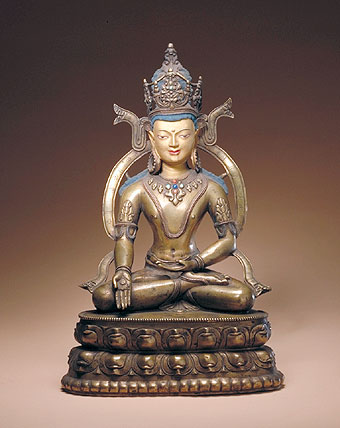Ratnasambhava
rin chen 'byung - Ratnasambhava [JV]
rin chen 'byung dan - Ratnasambhava [RY]
rin chen 'byung ldan - The Jewel-born, {rin chen 'byung gnas} Ratnasambhava [IW]
rin chen 'byung ldan - The Jewel-born. Syn {rin chen 'byung gnas} Ratnasambhava, Source of Preciousness [RY]
rin chen 'byung ldan - Ratnasambhava/ Source of Preciousness [RB]
rin chen 'byung gnas - Ratnasambhava; a mine of jewels, the buddha Ratnasambhava [central figure of the ratna family, one of the five buddha families; Ratnasambhava (yellow/ south/ jewel); one of the five buddhas. (RY)
rin chen 'byung gnas - 1) (met) ocean; 2) earth; 3) the buddha Ratnasambhava [central figure of the ratna family]; 4) mine of jewels) [IW]
rin chen 'byung gnas - 1) ocean; 2) earth; 3) the buddha Ratnasambhava; 4) mine of jewels [IW]
rin chen 'byung gnas rin chen - Source of jewels, Ratnasambhava, jewel family, rat na. (RY)
rin 'byung - Ratnasambhava [IW]
rin 'byung - rin chen 'byung gnas - Ratnasambhava. N. of a Buddha, Lord of the Jewel Family, one of the five buddha families. (RY)
rus rgyan drug - The six bone ornaments that are common for both the peaceful and wrathful deities are: the bone ornament at the crown of the head that symbolizes concentration and Akshobhya; the earrings that symbolize patience and Amitabha; the choker that symbolizes generosity and Ratnasambhava; the bracelets and anklets that symbolize discipline and Vairochana; the belt that symbolizes diligence and Amoghasiddhi; and the human ashes and Brahma cord on the torso that symbolize the Vajra Bearer or Vajradhara. [Jokyab Rinpoche] [RY]
rus rgyan drug - bone ornaments, six. The bone ornaments that are common for both the peaceful and wrathful deities are: the bone ornament at the crown of the head that symbolizes concentration and Akshobhya; the earrings that symbolize patience and Amitabha; the choker that symbolizes generosity and Ratnasambhava; the bracelets and anklets that symbolize discipline and Vairochana; the belt that symbolizes diligence and Amoghasiddhi; and the human ashes and Brahma cord on the torso that symbolize the Vajra Bearer or Vajradhara. [RY]
gsang snying gi dbang lnga - Five Empowerments According to the Secret Nucleus. They are also known as the five empowerments of ability {nus pa'i dbang lnga} which are included among the fifteen ordinary sacraments of Empowerment see below, namely, the empowerment of the listener {nyan pa'i dbang} which is that of Ratnasambhava, the empowerment of the meditator {bsgom pa'i dbang} which is that of Akshobhya, the empowerment of the expositor {chad pa'i dbang} which is that of Amitabha, the empowerment of enlightened activity {phrin las kyi dbang} which is that of Amoghasiddhi, and the empowerment of the king of indestructible reality {rdo rje rgyal po'i dbang} which is that of the five enlightened families. Refer to Longchenpa, {phyogs bcu mun sel} pp. 372-376. [GM] [RY]
